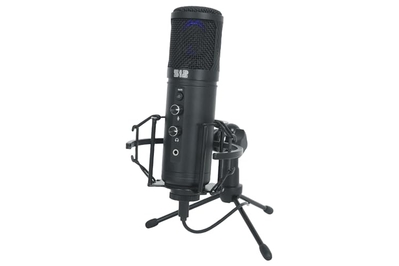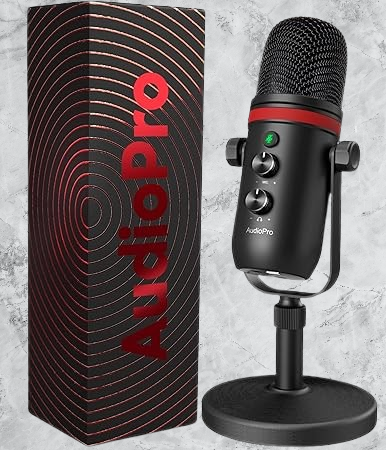USB Microphones
Top pick

No matter the testing conditions, our listening panel always chose the 512 Audio Tempest as one of their favorites. This microphone’s clear, natural sound works great for voices, music, and gaming, and its convenient controls and two mounting options add versatility.
It performs well on every task. The Tempest consistently ranked among the top microphones in our listening tests, whether we were recording music or vocals. Listeners commented on the above-average clarity of the sound in comparison with most of the other microphones we tested.
The cardioid pickup pattern is tight enough to cut out some room echo, but not so tight that vocalists will have to pay a lot of attention to staying close to the microphone.
The Tempest records at resolutions up to 24-bit/48 kHz, which is commonly used in professional recording. It seemed to produce less low-level hiss than many of the other microphones, although we’re not sure if that was due to less internal noise or less tendency to pick up room noise.
Behind the protective front grille is a fine-pitch metal screen that does a good job of blocking pops and plosives the way a pop filter would.
Front controls make it convenient to use. The microphone-gain and headphone-level knobs are right on the front, where they’re easy to access. The Tempest also has a front headphone jack and a mute button. Like most microphone mute buttons, this one produces a thump that comes through onto the recording, but it’s useful when you’re gaming with open-mic comms, where your microphone is always on.
A blue LED illuminates the microphone element so that you can stay on-mic even in a dark room. It looks cool, too.
You don’t need to buy anything else to get started. We love that 512 Audio includes two mounts and a rudimentary stand with the Tempest, so you don’t need to buy anything extra to start recording. Just attach the desired mount to the included tripod stand and connect the USB-C cable, and you’re ready to record.
The included shock mount suspends the microphone using rubber O-rings. This mount is useful in minimizing the effects of footfalls on a wooden floor, taps on a desktop keyboard, or inadvertent thumps on the desk. You’ll still hear such sounds, but you’ll hear little or none of the annoying, bassy random thumping that pervades so many amateur podcasts. The shock mount also provides a wide range of positions, so you can point the microphone high or low as needed.
The Tempest lists compatibility with only Windows and Mac computers, but we also got it to work with a Samsung Galaxy S10 Android phone. We couldn’t get it to work with a Lightning-jack-equipped iPad and an Apple camera adapter, though.
Flaws but not dealbreakers
The Tempest’s pricing is inconsistent. We were previously reluctant to make the Tempest a pick because depending on the retailer it sells at such a wide range of prices—from about $35 up to $160.
However, at this writing it has been consistently available for less than $50 on Amazon for at least nine months—and 512 Audio uses the same Amazon link for the buy option on its own website, so we feel safe recommending it.
The included stand is flimsy. The lightweight tripod stand is enough to get you started, but we recommend replacing it soon. If you use the shock mount, the microphone hangs out far beyond the included stand’s center of gravity, and the whole thing can fall over with just an accidental tap. We recommend getting a weighted desktop stand.
We’ve seen complaints about the mute button malfunctioning. Some Amazon reviewers report that the Tempest’s mute button stops working after a while. The button on our test unit still worked fine after more than 500 presses, but it might be wise to give yours a workout and confirm you got a good one.
No matter the testing conditions, our listening panel always chose the 512 Audio Tempest as one of their favorites. This microphone’s clear, natural sound works great for voices, music, and gaming, and its convenient controls and two mounting options add versatility.
It performs well on every task. The Tempest consistently ranked among the top microphones in our listening tests, whether we were recording music or vocals. Listeners commented on the above-average clarity of the sound in comparison with most of the other microphones we tested.
The cardioid pickup pattern is tight enough to cut out some room echo, but not so tight that vocalists will have to pay a lot of attention to staying close to the microphone.
The Tempest records at resolutions up to 24-bit/48 kHz, which is commonly used in professional recording. It seemed to produce less low-level hiss than many of the other microphones, although we’re not sure if that was due to less internal noise or less tendency to pick up room noise.
Behind the protective front grille is a fine-pitch metal screen that does a good job of blocking pops and plosives the way a pop filter would.
Front controls make it convenient to use. The microphone-gain and headphone-level knobs are right on the front, where they’re easy to access. The Tempest also has a front headphone jack and a mute button. Like most microphone mute buttons, this one produces a thump that comes through onto the recording, but it’s useful when you’re gaming with open-mic comms, where your microphone is always on.
A blue LED illuminates the microphone element so that you can stay on-mic even in a dark room. It looks cool, too.
You don’t need to buy anything else to get started. We love that 512 Audio includes two mounts and a rudimentary stand with the Tempest, so you don’t need to buy anything extra to start recording. Just attach the desired mount to the included tripod stand and connect the USB-C cable, and you’re ready to record.
The included shock mount suspends the microphone using rubber O-rings. This mount is useful in minimizing the effects of footfalls on a wooden floor, taps on a desktop keyboard, or inadvertent thumps on the desk. You’ll still hear such sounds, but you’ll hear little or none of the annoying, bassy random thumping that pervades so many amateur podcasts. The shock mount also provides a wide range of positions, so you can point the microphone high or low as needed.
The Tempest lists compatibility with only Windows and Mac computers, but we also got it to work with a Samsung Galaxy S10 Android phone. We couldn’t get it to work with a Lightning-jack-equipped iPad and an Apple camera adapter, though.
Flaws but not dealbreakers
The Tempest’s pricing is inconsistent. We were previously reluctant to make the Tempest a pick because depending on the retailer it sells at such a wide range of prices—from about $35 up to $160.
However, at this writing it has been consistently available for less than $50 on Amazon for at least nine months—and 512 Audio uses the same Amazon link for the buy option on its own website, so we feel safe recommending it.
The included stand is flimsy. The lightweight tripod stand is enough to get you started, but we recommend replacing it soon. If you use the shock mount, the microphone hangs out far beyond the included stand’s center of gravity, and the whole thing can fall over with just an accidental tap. We recommend getting a weighted desktop stand.
We’ve seen complaints about the mute button malfunctioning. Some Amazon reviewers report that the Tempest’s mute button stops working after a while. The button on our test unit still worked fine after more than 500 presses, but it might be wise to give yours a workout and confirm you got a good one.
The 4 Best USB Microphones for Musicians and Podcasters in 2025
[title_words_as_hashtags








[…] Another good option: The GE Cync Direct Connect ST19 is a more affordable smart filament bulb that supports both the Amazon Alexa and Google Home platforms. We found the Cync app less polished than the Hue app, and we had trouble locating some features. Also, unlike the Philips Hue bulb, the GE Cync bulb’s color temperature isn’t tweakable; it’s fixed at a warm 2,700 K, which is attractive. This bulb is still a good option if you want a vintage-look Edison-style bulb with useful smart features such as remote on/off control, scheduling, and the ability to customize Scenes. […]